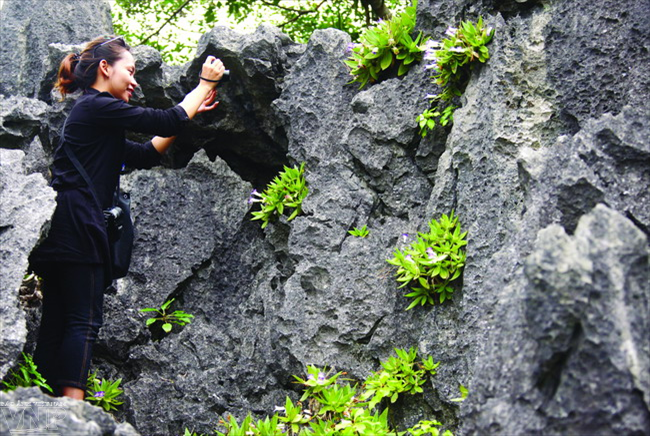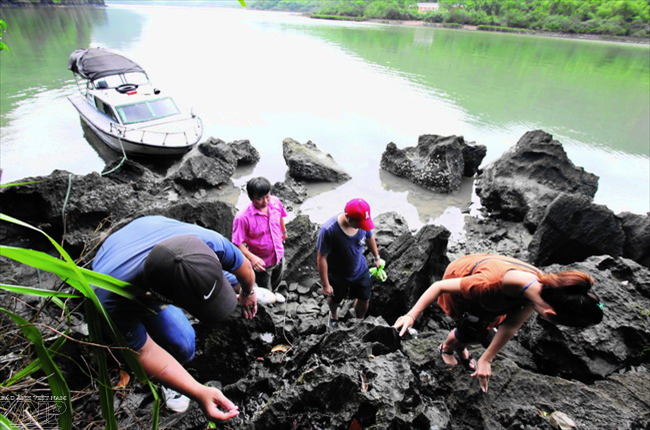Starting from the wharf on the island commune of Minh Chau (Van Don District, Quang Ninh Province), our motorboat steered by Nguyen Dang Khoa, Deputy Head of Bai Tu Long National park Management Department ran along the inlets through ranges of mountains to go to Bai Tu Long National Park. After 10 minutes our boat reached Ba Mun Island which has the characteristics of the forest ecosystem in the park.
East of Ba Mun Island, the sea had big waves with white foam splashing spray to a height of dozens of meters, while in the west, the sea was calm with a smooth water surface. The island is considered a shield protecting the district residents against the squalls from the sea.
The forests on Ba Mun Island have many rare species of animals, such as the clouded pythons, Asian golden cats, golden monkeys, pangolins and geckos. The forests have the highest density of ungulates and are considered the largest nature reserve of wild animals in northeast Vietnam. The flora on the island is extremely rich and diverse with 780 species of high-grade plants, including species of trees like iron wood (erythrophleum fordii), teak wood and pedocarpus fleurgi.
In 2010, Ba Mun Island became a place where the largest wild animal rescue centre in northeast Vietnam was established. Now, the centre is caring for and nurturing many species of wild animals, such as bears, red-faced monkeys, long-tailed monkeys, porcupines and striped box turtles which have been confiscated and rescued from illegal smuggling of wild animals at sea. The establishment of the centre shows that the conservation and development at Bai Tu Long National Park has been emphasized and systematically implemented.
Leaving Ba Mun Island we went to Tra Ngo Lon Island, the largest karst island in Bai Tu Long National Park. It has a fairly special geological structure, with earthen mountains in the north and karst mountains with many caves and valleys in the south, creating a special and attractive landscape. Lying in the centre of the island is Cai Lim with a mangrove forest ecosystem.
| «
Bai Tu Long National Park has a total area of 15,783ha of which the sea accounts for 9,658ha and the islands account for 6,125ha. It has 1,909 species of animals and plants, in which 72 species of animals and 30 species of plants have been listed in Vietnam’s Red Book.
»
|
According to Pham The Toan, Chief of Cai Lim Forest Management Station, the mangrove forests on Tra Ngo Lon Island have the richest and most diverse flora in northeast Vietnam. Many survey teams from the Global Environment Fund of Japan (JGEF) and the Vietnam National Parks and Protected Areas Association (VNPPA) were very surprised to find a year-old ecosystem of mangrove forests in the park. According to scientists, the mangrove forests on Tra Ngo Lon Island in particular and in Bai Tu Long National Park in general have no alluvia as do the mangrove forests in the Red River estuary. The nutritious source here is mainly accumulated mud and soil coming down from the mountains. It has taken Tra Ngo Lon Island hundreds of years, to have rich mangrove forest vegetation as today.
These mangrove forests are isolated at sea, so very few people go to this area. Our guide said that we were among few reporters who were lucky to go to these forests, which made us more excited and curious to quickly explore them.
We went into Cai Lim Valley which has been assessed by scientists as having many forms of “incomparable” vegetation compared to other mangrove forests in Vietnam. We had to go through a forest of thick green bamboo trees to reach a forest of coccoloba uvifera where generations of the trees grow together, the little saplings mingling with the old trees of hundreds of years.
There are also old Gia bien trees with a diameter of four people’s embrace. The further we went, the more strange things we found. For example, thick layers of vegetation of an orchid family grow on the limestone and on the branches and trunks of the mangrove trees. Among them there are species of orchids which have been listed in Vietnam’s Red Book. This is an unprecedented phenomenon compared to other mangrove forests in Vietnam as confirmed by many scientists.
It may be the reason why VNPPA scientists have considered Cai Lim area a “living museum” showing the evolutionary history of the organisms.
A Destination at Sea
Leaving the area of Cai Lim we continued our motorboat ride through the inlets created by thousands of islands in the park. Pham Xuan Phuong, Deputy Chief of the Scientific Department of Bai Tu Long National Park said that the topography of the inlets’ bottoms is very complicated. It was formed in the process of underground abrasion, erosion and accumulation. These are the characteristics that make the coral reefs in Bai Tu Long National Park scattered, mostly in the form of blocks and coating clinging to the cliffs which are strongly affected by the waves and currents of the sea.
The coral population in Bai Tu Long National Park is an important marine ecosystem and has special scale and size. Mang Khoi and Dau Cao are two places which provide the best view of coral. According to the survey documents, Mang Khoi has nearly 40 of the total 106 species of corals. The coral here is mainly in the form of branches and blocks and are a food source for many rare species of high economic value, such as sea cucumbers and coral trout.
Talking about the ecosystem of Bai Tu Long National Park, Le Van Lanh said it was the most special ecosystem in the park. The evidence is that there are species of marine animals, such as dolphins and abalones. Of the seven turtles listed in Vietnam’s Red Book, the park has five species including the olive ridley sea turtles, hawksbill sea turtles, green sea turtles, loggerhead sea turtles and leatherback sea turtles. The conservation of these special species has been especially emphasized. In March, 2006 the International Union for Conservation of Nature (IUCN) which has a representative office in Vietnam started a project on monitoring the information about the sea turtles, based in the community in Minh Chau Commune.


Surveying the coral reefs in the east of Ba Mun Island. Photo: Bai Tu Long National Park’s file



Bai Tu Long National Park is the ideal destination for tourists who are interested in discovering the wild and natural landscape.
Photo: Viet Cuong |
After only three months of implementation, the project has achieved successful results. The authorities and people in Minh Chau Commune have discovered and protected one hatch of turtle eggs on the beach and timely returned a mother turtle back to the sea. The sea turtles have come back to the park to build their nests and lay eggs. The more important thing from this project is that the residents in Minh Chau District have been made aware to monitor and provide information and participate in the conservation. This is really a good and remarkable signal of the efforts and creativity of the management board of Bai Tu Long National Park in the conservation of the sea in general and the sea turtles in particular.
Since 2006 the park has coordinated with VNPPA and JGEF to carry out many activities to develop eco-tourism such as surveying tourism resources, organizing training courses to improve the professional skills in eco-tourism for the cadres of the park and organizing workshops to promote eco-tourism.
Together with the g
uide, we continued our boat ride on the inlets between the rocky and earthern islands. We saw many islands in strange shapes, one looking like a swimming swan, another looking like a gigantic stone horse, and Mau Tu and Thien Thu Islands. All of them create a wild magnificent landscape of nature. It is an invaluable gift endowed to Bai Tu Long National Park by nature.
When we finished our full-day trip in the park, Pham Xuan Phuong told us that the park was preparing to submit a file to the ASEAN Secretariat for its recognition of Bai Tu Long National Park as ASEAN Heritage Park by 2014.
The wild and wonderful natural world of Bai Tu Long National Park not only has a great scientific value but also has special tourist attraction. For the conservation and sustainable development of the ecological values and special landscape of the park, the park’s management board has organized the popularization and education to raise the people’s awareness of forest protection. Also, it has promoted research and sought directions to develop appropriate forms of tourism so that this potential “treasure” is not forgotten at sea.
Story: Thao Vy - Photos: Trong Chinh, Viet Cuong & Bai Tu Long National Park’s Files